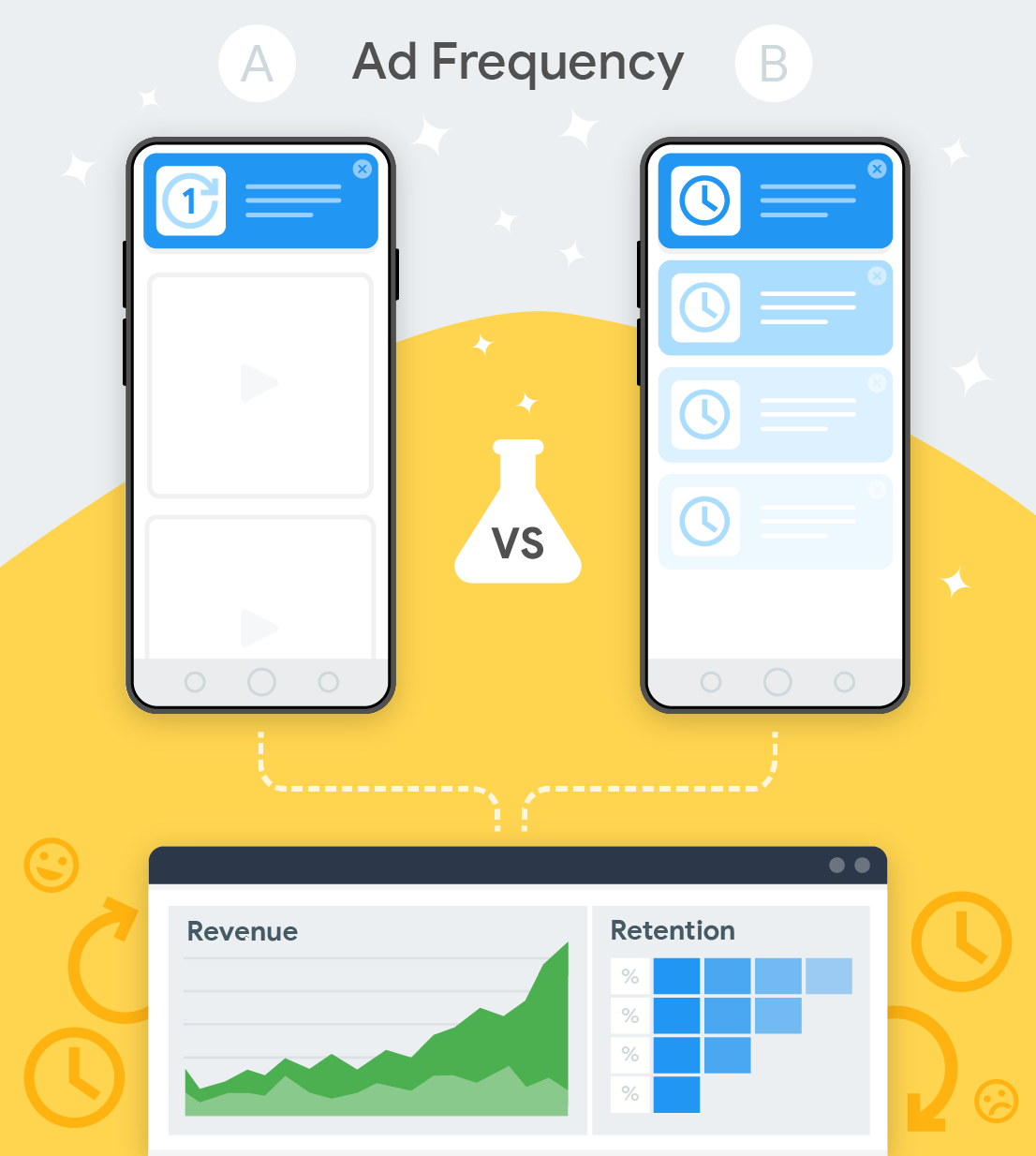
Çözüm eğitimi
Yüksek kaliteli bir kullanıcı deneyimi sunarken reklam sıklığını optimize etmek zor olabilir ancak Firebase, test yapmanıza ve ardından ideal reklam sıklığı hakkında veriye dayalı kararlar almanıza yardımcı olacak araçlar sunar.
Firebase'i kullanarak çeşitli reklam sıklıklarının performansını kullanıcıların küçük bir alt kümesiyle A/B testine tabi tutabilirsiniz.
Test sonuçlarını gözlemleyebilir ve Firebase'in, elde tutma üzerinde minimum etkiyle hangi reklam sıklığının daha iyi performans gösterdiğiyle ilgili önerilerini inceleyebilirsiniz.
Değişikliklerin olumlu bir etki yaratacağından emin olduğunuzda, tek bir tıklamayla değişiklikleri daha fazla kullanıcınıza uygulayabilirsiniz.
Neler öğreneceksiniz?
Bu çok adımlı eğitimde, uygulamanızdaki Google AdMob reklamları için çeşitli sıklık sınırlarını test etmek amacıyla Firebase'i nasıl kullanacağınızı öğreneceksiniz. Eğitimde örnek test durumu olarak geçiş reklamları kullanılsa da aynı adımları diğer reklam biçimlerinde sıklık sınırını test etmek için de kullanabilirsiniz.
Bu eğitimde, uygulamanızda AdMob kullandığınız ve bir geçiş reklamı biriminin sıklığını değiştirmenin uygulamanızın geliri veya diğer metrikleri üzerinde etkili olup olmayacağını test etmek istediğiniz varsayılmaktadır. Ancak uygulamanızda AdMob kullanmıyorsanız sorun değil. Bu eğiticideki adımlar, uygulamanızda hangi reklam sıklığını kullanmanız gerektiğini anlamanıza da yardımcı olabilir.
Optimize AdMob ad frequency çözümüne genel bakış başlıklı makalemizden bu çözümün iş gerekçesi ve değeri hakkında daha fazla bilgi edinin.
Bu eğitimde kullanılan ürünler ve özellikler
|
Google AdMob Google AdMob, uygulamanızda yayınlanacak çeşitli reklam sıklıklarına veya yenileme hızlarına sahip reklam birimleri oluşturmanıza olanak tanır. AdMob'i Firebase'e bağladığınızda AdMob, reklam stratejisi optimizasyonunu iyileştirmek için reklam geliri bilgilerini Firebase'e gönderir. Google Analytics Google Analytics, kullanıcı etkileşimi, elde tutma ve para kazanma metrikleri (ör. toplam gelir, AdMob geliri, satın alma geliri) hakkında bilgi edinmenizi sağlar. Ayrıca, kullanıcı kitleleri ve segmentleri oluşturmanıza da olanak tanır. |
Firebase Remote Config Firebase Remote Config, uygulamanızın davranışını ve görünümünü istediğiniz kullanıcı segmentleri için dinamik olarak değiştirip özelleştirmenize olanak tanır. Tüm bunları uygulamanızın yeni bir sürümünü yayınlamadan yapabilirsiniz. Bu eğitimde, kullanıcılarınıza hangi reklam biriminin gösterileceğini kontrol etmek için Remote Config parametrelerini kullanacaksınız. Firebase A/B Testing Firebase A/B Testing, uygulamanızda ürün ve pazarlama denemeleri yapmak için arayüz ve altyapı sağlar. Deneme varyantlarını kullanıcılara dağıtma işlemini gerçekleştirir ve ardından, gelir veya kullanıcı elde tutma gibi seçtiğiniz temel metriğe göre bir deneme varyantının kontrol grubundan daha iyi performans gösterip göstermediğini belirlemek için istatistiksel analiz yapar. |

Eğiticiye genel bakış
Doğrudan adım adım açıklamalı eğitime gidin
Test için yeni reklam birimi varyantları oluşturmak üzere AdMob simgesini kullanma
AdMob'da iki yeni geçiş reklamı birimi oluşturun.
Her reklam biriminin Sıklık sınırı'nı, test etmek istediğiniz kullanıcı başına gösterim değerine ayarlayın.
Reklam birimi yerleşimlerini uygulamanızın koduna yerleştirin.
Firebase konsolunda A/B testi oluşturma
Testin temel unsurlarını, hedeflemeyi ve testin karşılaştırılacağı hedefleri tanımlayın.
Test varyantlarını tanımlayın ve testteki kullanıcılara hangi reklam biriminin gösterileceğini kontrol edecek Remote Config parametresini ayarlayın.
Uygulamanızın kodunda Remote Config parametre değerlerini işleme
Uygulamanızda Remote Config parametresini kullanın.
Reklam birimini parametrenin değerine göre görüntüleme mantığını uygulayın.
A/B testini başlatın ve test sonuçlarını Firebase konsolunda inceleyin
Testi başlattıktan ve birkaç gün veya hafta boyunca çalışmasına izin verdikten sonra, A/B testinin bir kazanan varyantı olup olmadığını görmek için Firebase konsolunu kontrol edin. Bu kontrolü, A/B testinin birincil hedefine göre yapın.
Varyantların bu metrikler üzerinde istenmeyen olumsuz etkiler yaratmadığından emin olmak için her varyantın ikincil metrikler üzerindeki etkisini inceleyin.
-
A/B Testing, yeni reklam biçimini gösteren varyantın kazanan olduğunu belirlerse reklam biçimini denemede hedeflenen tüm kullanıcılara, uygulamanızın tüm kullanıcılarına veya kullanıcılarınızın bir alt kümesine göstermeye başlayabilirsiniz.
Henüz net bir kazanan belirlenmediyse daha fazla veri toplamak için denemeyi çalıştırmaya devam edebilir veya deneme uzun süredir kesin olmayan sonuçlarla çalışıyorsa denemeyi sonlandırabilirsiniz.
Gerekenler
Kendi uygulamanız (iOS, Android veya Unity projesi)
Uygulamanız, bir AdMob uygulamasına bağlı bir Firebase uygulaması olarak kaydedildi (daha fazla bilgi).
Uygulamanızın ilişkili AdMob hesabına erişim ve yeni reklam birimleri oluşturma izni
Uygulamanızın ilişkili Firebase projesine erişim (Remote Config ve A/B Testing oluşturma ve yönetme ile Google Analytics görüntüleme izinleriyle birlikte)
Tercih ettiğiniz IDE
Sözlük
1. adım: Yeni reklam birimi varyantları oluşturmak için AdMob simgesini kullanın

